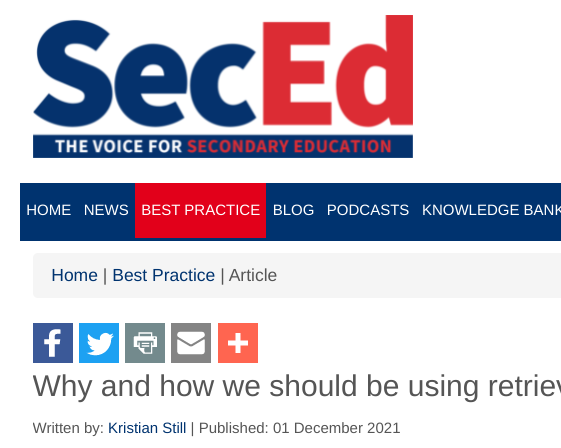“I’ll pour this pestilence into his ear”
Act 2 Scene 3
It has been a while since I got behind the keyboard to blog. Following the positive reception to “Why and how we should be using retrieval practice and space learning,” I been working on the follow up. I was asked if I would expand upon each of the component parts; retrieval practice, spacing, interleaving, feedback and metacognition as a series.
That list got extended. I added a post on motivation (thanks @MrClassics) and split metacognition in two, metacognition and the “illusions of competence.” These seven drafts have taken up all of my spare time (and more) and will hopefully be published sometime between late Feb-March time.
For now – one interesting side track and boundary condition of retrieval practice that didn’t warrant an individual post is task complexity. It easily could as it is a topic that have led to some vociferous debate but it’s pretty niche. Think of it as – where retrieval practice meets Cognitive Load Theory. And if we are leaning on Cognitive Load Theory (CLT) and discussing “task complexity,” we should also mention “task interactivity.” That is, when knowledge items interact with each other or where one piece of information depends on an understanding of another. Let’s stick with van Gog & Sweller (2015) example – “eg the mechanics of a hydraulic car brake system.”
Task complexity and interactivity
Task complexity and interactivity is an important consideration, a condition that also interacts with motivation, metacognition and the transfer benefits of retrieval practice. With most retrieval research methodologies based on paired associate retrieval tasks I can understand where the challenge stems from.
Another potential boundary condition concerns the complexity of learning materials, that is, the number of interacting information elements a learning task contains. This insight is not new, as research from a century ago already had indicated that the testing effect decreases as the complexity of learning materials increases, but that finding seems to have been nearly forgotten.
van Gog & Sweller (2015)
The inference is that the learning is simple, with low element interactivity. Second that the learning benefits that arise during encoding (associations / discrepancies between elements established through testing) are lost when the knowledge is complex or has high element interactivity.
In summary, Van Gog and Sweller (2015) suggest that complex learning tasks that are high in element interactivity, may be “immune to the benefits of testing.” Alternatively, that task complexity may “reduce or even eliminate … the testing effect.” And so, what does that mean for the effectiveness of retrieval practice for complex and highly interactive learning?
Task complexity and interactivity matters
Of course task complexity and interactivity matters. I have never said that retrieval practice is the answer to all learning and teaching. If anything, I have positioned retrieval practice as a way of “shoe-horning” knowledge in, and more importantly getting knowledge out, with which students can think more deeply about the subject.
Van Gog & Sweller (2015) suggest that it is not only necessary to learn the pistons and cylinders but rather how these components interact to understand hydraulic multiplication and friction. I tend to disagree.
How are students to empathise with Othello ill informed decisions, without at least a mere smattering of knowledge about the Elizabethan Venetian society? How are you – the reader, if you do not know the play?
Retrieval practice and complex tasks
Does that mean retrieval practice is ineffective when knowledge is complex? No, of course not. Even our esteemed colleagues suggest that we not be too hasty.
Karpicke and Aue (2015) were both swift and acertive in their challenge. Certainly,
Retrieval practice remains an effective way to improve meaningful learning of complex materials.
Karpicke and Aue (2015)
I would also agree with them that free recall, summarisation and concept mapping require high degrees of element interactivity by their very nature. Certainly the research on knowledge transfer would suggest interactivity also.
Define and design
As with almost all teaching, define what is to be taught and design how it will be taught. Ascertain what the students already know — and start from there.
Van Gog & Sweller (2015) point out:
It would help teachers and instructional designers to know for which learning tasks they can and cannot expect benefits of having their students take practice tests instead of engage in further study.
Van Gog & Sweller (2015)
When it comes to retrieval practice, I would most certainly agree.
Define the knowledge and use testing to enhance learning and retention. There is motivation and curiosity to be harvested here. Knowledge with which students can think more deeply about the subject, be it Othello’s crisis of confidence or hydraulic break systems. Then define how this knowledge interacts. A task my gut tells me, should be a more achievable with more durable and more accessible, if simpler, knowledge.
For the time being, Karpicke and Aue (2015) have their tanks out on the lawn: “the testing effect is alive and well with complex materials.”


